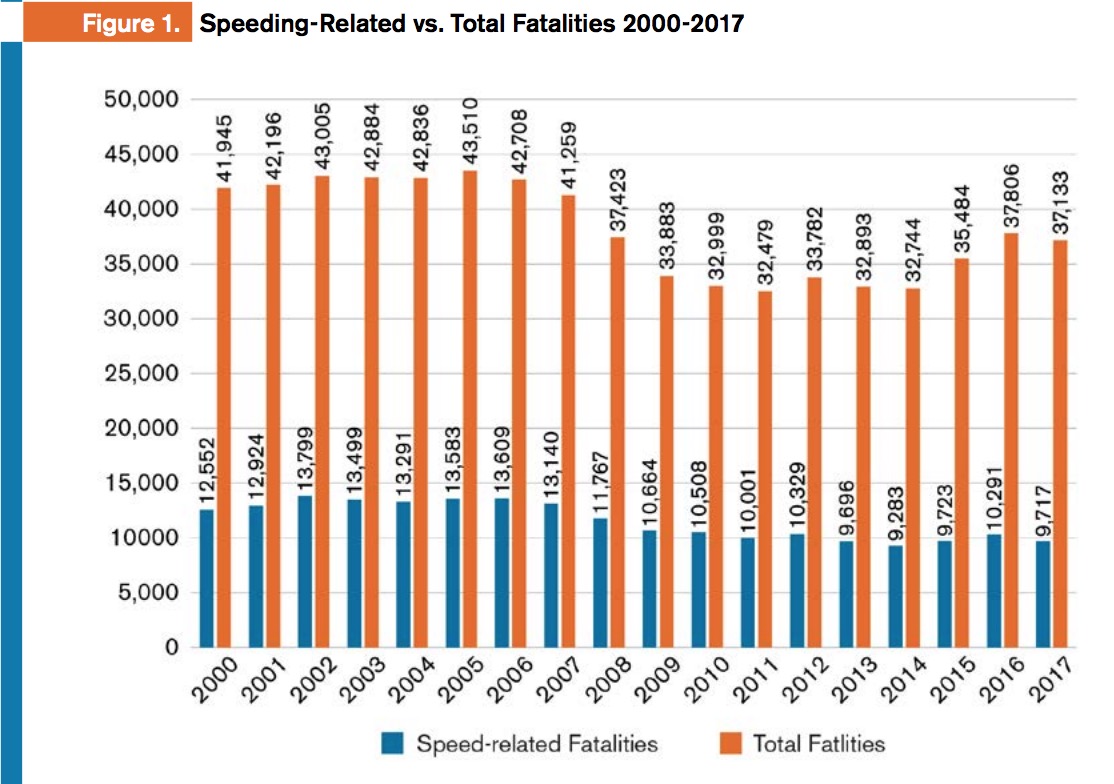GOVERNORS HIGHWAY SAFETY ASSOCIATION
Summary
Speeding-related fatalities account for a considerable proportion of U.S. road trauma, historically comprising approximately one-third of total fatalities. Nationally, there were 9,717 speeding-related fatalities in 2017 – about 26% of the total, though the proportion of speeding crashes differs dramatically across the states. Speeding-related fatalities are associated with a number of factors, including driver characteristics, risky behaviors such as alcohol-impaired driving, marijuana-impaired driving or failure to buckle up, and environmental factors such as the built environment and driving conditions. Speeding-related crashes also have unique impacts for vulnerable road users, such as pedestrians, bicyclists, motorcyclists and roadside workers. Overall progress on the issue of speeding has been limited at best.
Speeding remains a publicly-accepted driving behavior that is reinforced among motorists, policymakers and transportation stakeholders. National surveys of U.S. drivers have found that although drivers identify speeding as risky, drivers nonetheless continue to speed. Drivers have a minimal perception of risk of either getting a ticket, causing a crash, or violating social norms.
Federal, state and local policymakers are approaching speed management in different ways, but these approaches often reflect the current cultural attitude towards speeding. Some states are increasing certain speed limits, while others are granting more local discretion to set speeds according to local needs. The collection and aggregation of accurate data about speeding-related crashes remains a challenge. Speed management initiatives often face political roadblocks and a shortage of resources.
Fortunately, states and municipalities also have available guidance on a range of infrastructure-based approaches that can prevent or mitigate speeding. Many states and communities are exploring more integrated traffic safety programs that aim to coordinate interdisciplinary speed management efforts. A number of technological approaches to speed management are available, but widespread deployment among passenger vehicles may be a long-term process.
The traffic safety community must take a number of key action steps to better address speeding. The federal government should better prioritize speeding as a leading traffic safety issue and create new federal programs to address it. States and municipalities should consider task forces or advisory committees to better coordinate speed management, promote crash report and crash database improvements, and explore the use of integrated speed management programs.
States and local governments should increase speeding enforcement, including thoughtful deployment of automated speed enforcement, and train law enforcement officers to better document speeding-related crashes. These entities should set appropriate speed limits and continue to deploy roadway infrastructure to better control speed.
Finally, while many states and communities are conducting media and educational outreach campaigns about the dangers of speeding, the traffic safety community should consider developing a more innovative approach to changing social norms that gives voice to speeding crash victims and creates a new wrong-doing traffic safety archetype: the speeding driver.
To create this report, the Governors Highway Safety Association (GHSA) requested speeding-related data from the states to gather subject matter expert knowledge on obstacles, successes and other factors related to speeding. Speeding-related fatality counts were obtained from the National Highway Traffic Safety Administration (NHTSA) Fatality Analysis Reporting System (FARS) database and NHTSA Traffic Safety Research reports.
Introduction
 This report presents speeding-related fatality trends according to data collected by the National Highway Traffic Safety Administration Fatality Analysis Reporting System, documents and summarizes information collected from the states, and reviews policy, programmatic, and cultural trends related to speeding.
This report presents speeding-related fatality trends according to data collected by the National Highway Traffic Safety Administration Fatality Analysis Reporting System, documents and summarizes information collected from the states, and reviews policy, programmatic, and cultural trends related to speeding.
The Safety Risk Presented by Higher Speeds is Undisputed
According to the International Traffic Safety Data and Analysis Group (IRTAD), speed has a direct influence on crash occurrence and severity. With higher driving speeds, the number of crashes and the crash severity increase disproportionally. With lower speeds, the number of crashes and the crash severity decrease (IRTAD, 2018). Fatal single vehicle crashes are typically related to speed and/or distraction (Liu and Chen, 2009). Several research reports, have identified higher speeds as a significant factor in determining injury severity (Hu et. al, 2016; NTSB, 2017). The Insurance Institute for Highway Safety reports that speed influences the risk of crashes and crash injuries in three ways:
- The distance a vehicle travels from the time a driver detects an emergency to the time the driver reacts is increased.
- The distance needed to stop a vehicle once the driver starts to brake is increased.
- The exponential increase in crash energy. For example, when impact speed increases from 40 to 60 mph (a 50% increase), the energy increases by 125% (IIHS, 2018b).
The force involved in a crash is directly related to the speed at the time of a crash. In a high-speed crash, a passenger vehicle is subjected to forces where the structure of the vehicle cannot withstand the force of the crash and maintain survival space within the occupant compartment of the vehicle. In addition, in high speed crashes, restraint systems such as airbags and safety belts are incapable of minimizing these higher levels of force (IIHS, 2018b).
The Current Climate of Speeding in the United States
In today’s life, a high degree of mobility and the ability to travel quickly by air, rail or road seems to have become an everyday expectation of modern society. NHTSA studies have shown that most traffic exceeds posted speed limits, and this culture is mutually reinforced between drivers, policymakers and many transportation stakeholders. While speeding may seem like a new challenge, we are in fact managing the legacy of a decades-long culture oriented towards minimizing travel times. Many existing roads do not reflect the latest speeding-related guidelines, and some roads even predate any explicit consideration of vehicle speeds (FHWA, 2009). Added to this are current cultural obsessions with fast cars, horsepower, racing, and a clear, ongoing interest and willingness to move fast.
While speed is often used as a measure of mobility, high speeds also impose a clear safety toll (FHWA 2009). According to NHTSA, there were 9,717 speeding-related fatalities on U.S. roadways in 2017, and speeding-related fatalities made up 26.2% of the nation’s total fatalities (NCSA, 2018d). This safety toll is persistent as excessive speed has long accounted for a considerable proportion of U.S. road trauma. Speeding-related fatalities as a percent of total motor vehicle fatalities vacillated between 32% and 31% from 2001 to 2012 (NCSA, 2018d). The National Transportation Safety Board (NTSB) reported that speeding is one of the most prevalent risky driving behaviors on U.S. roadways and a common factor in motor vehicle crashes, and that speeding has been a causal or contributing factor in 49 major NTSB highway accident investigations since 1967 (NTSB, 2017).
Both speeding-related fatalities and total motor vehicle fatalities trended downward from 2005 to 2011 (Figure 1). These declining trends may be attributed to the implementation of safety improvements including air bags, increased seat belt use, and other passenger vehicle safety features. However, the declining trend in total motor vehicle fatalities reversed in 2015.
In 2010, speeding-related fatalities as a percentage of total motor vehicle fatalities began declining as total motor vehicle fatalities stayed consistent until 2015 then started trending upward. During this time there was a 6% decrease in speeding-related fatalities, from 32% in 2010 to 26% in 2017.
Speeding-related deaths as a percent of the total motor vehicle deaths were calculated for each state for 2017. 2017 FARS data was queried to calculate the speeding-related deaths as a percent of total motor vehicle deaths for 2017 (Figure 2). New Hampshire and Washington, D.C. had the top two percentages for both years, with more than half of motor vehicle deaths classified as speeding-related.
This state-by-state variation, ranging from 57% to 9% of total motor vehicle deaths, is striking. By comparison, the percentage of alcohol-impaired driving fatalities in 2017 ranges only from 51% to 19% (NCSA, 2018a). These findings suggest that many factors could be impacting speeding practices, including different travel trends, roadway environments, laws and programs. As discussed below, there are also variations in the data collection practices that likely result in underreporting of speeding-related crashes. Most importantly, these differences suggest that there may be promising best practices that can be applied widely.
State Survey on Speeding Trend Factors
In August 2018, GHSA surveyed states to determine potential trends regarding speeding-related fatalities and explanations for these trends within the states. Responses were collected from all 50 states and the District of Columbia. Responses to questions are based on the respondents’ experience and content knowledge as subject matter experts for the states, not scientific analyses.
The states reported a number of factors that may play a role in increases in speeding-related fatalities (in no particular order):
- Increased speed limits;
- Limited law enforcement resources;
- Lack of a federal traffic safety grant program focused exclusively on speed enforcement;
- Overall increases in motor vehicle crashes and vehicle miles traveled;
- Greater distances to and from work or recreational destinations, therefore increasing the number of speeding incidents;
- Increased congestion on major roadways due to volume, causing drivers to try to make up time for the perceived time spent in traffic;
- Updated crash reports and data systems that now more effectively report speeding-related crashes and fatalities;
- Inclement weather such as ice and snow in states with colder winter months;
- Population increases;
- Higher incidences of distraction among drivers; and
- Recreational marijuana legalization.
The states also reported factors that could decrease speeding-related fatalities, including:
- Overall declines in total motor vehicles deaths;
- High visibility enforcement (HVE) of occupant protection laws and seat belt media campaigns;
- Increased engineering efforts incorporating traffic calming features; and
- Reductions in teen driver registrations and licenses issued during the past few years, reducing exposure for the younger age categories.
The role of many of these observed factors in speeding-related crashes is supported by crash data and research, as described below.
Download full version (PDF): Speeding Away from Zero
About the Governors Highway Safety Association
https://www.ghsa.org
GHSA is a 501(c)(3) nonprofit representing the state and territorial highway safety offices that implement federal grant programs to address behavioral highway safety issues. GHSA has two tiers of membership: its core State Highway Safety Office (SHSO) Members and Associate Members.
Tags: GHSA, Governors Highway Safety Association, Road Safety, safety, Speeding, Traffic Fatalities







 RSS Feed
RSS Feed